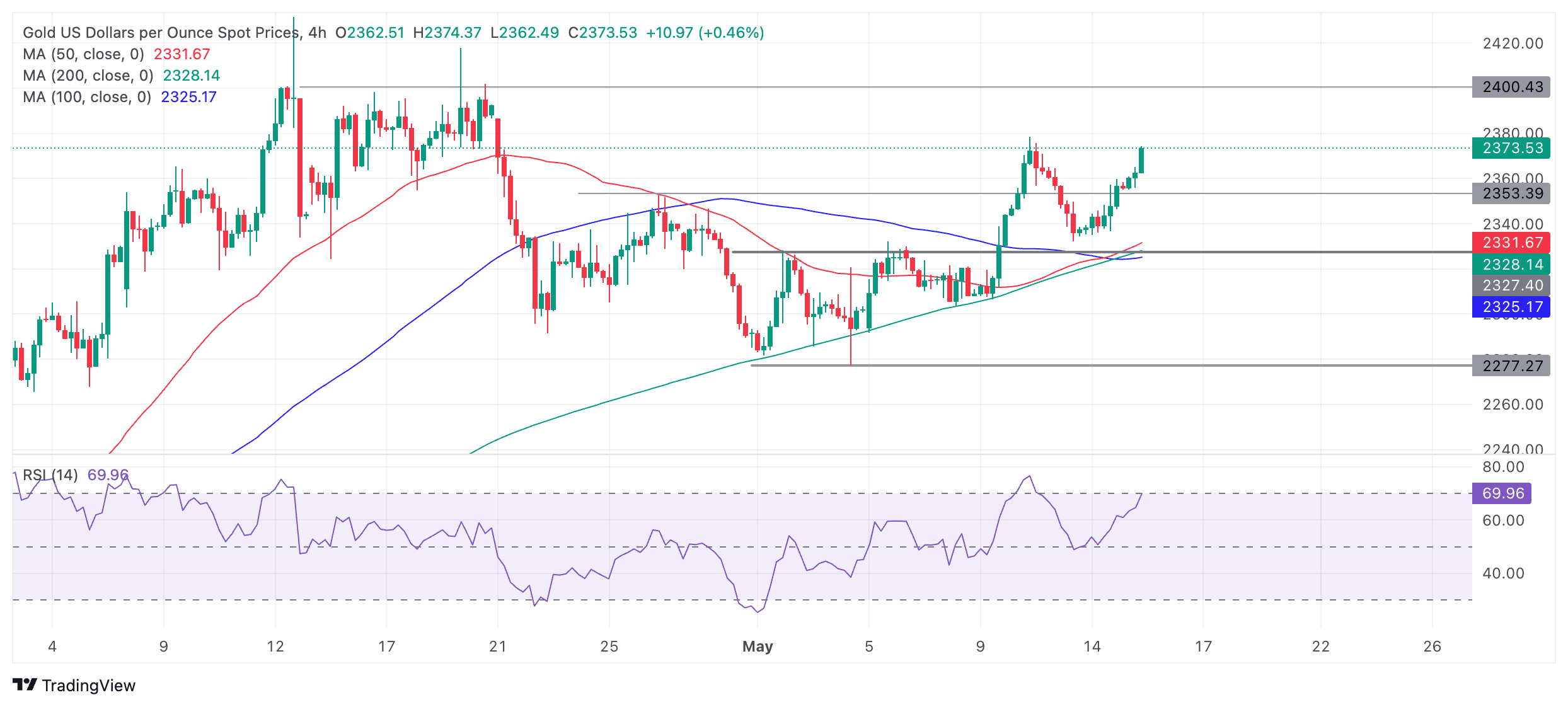- Gold is again approaching May highs as buyers continue to pile in amid underlying geopolitical tensions.
- The strong demand from central banks is a key factor in keeping the precious metal supplied.
- After a deep correction, the XAU/USD resumes its bullish bias and pushes the cross higher.
The price of Gold (XAU/USD) is trading higher on Wednesday, up around half a percentage point at $2,360, as continued hoarding by central banks in the wake of geopolitical tensions drives demand. .
However, the rally could be limited by comments from Federal Reserve (Fed) Chairman Jerome Powell, who suggested that higher interest rates are here to stay, which maintains the opportunity cost of holding the precious metal. without performance at an unattractive level.
Gold price rises thanks to sustained demand
The price of Gold rose on Wednesday, as the outlook for demand for the precious metal remains bullish amid continuing global trade and geopolitical tensions.
In a speech last week at Stanford, Gita Gopinath, First Deputy Managing Director of the International Monetary Fund (IMF), stated that central banks, especially in emerging markets, have been hoarding gold in recent years as a hedge against the risk of , among other things, the sanctions imposed by the West.
“Gold purchases by some central banks may have been driven by concerns about the risk of sanctions. This is consistent with a recent IMF study confirming that currency reserve managers tend to increase their gold holdings as a hedge.” in the face of economic uncertainty and geopolitical risk, including sanctions,” Gopinath said.
This view is also supported by data from the World Gold Council (WGC), which shows strong demand in 2024 from central banks.
Given the growing tensions in the Middle East, Ukraine and the increasingly polarized confrontation between the BRICS nations and allies led by the US, the trend is expected to continue, maintaining support for Gold prices.
Inflation data in the US waiting
The price of Gold is likely to be affected by the US Consumer Price Index (CPI) data due to be released on Wednesday, due to its influence on US interest rates. If the CPI data reflects a rise in inflation, it will force the Fed to keep interest rates at their current level or higher for longer. In turn, this is likely to have a negative impact on the price of Gold.
In a speech on Tuesday, Federal Reserve Chairman Jerome Powell suggested that interest rates would remain high for an extended period.
“Inflation in the first quarter was notable for the lack of further progress,” Powell said, adding: “We were not expecting a smooth ride on inflation, we have to be patient and let politics do its job.”
Although the Fed had anticipated several rate cuts in 2024, comments from many Fed officials, including Powell, have reflected a change in stance. Now, officials say the Fed needs to keep interest rates at their current level to sustainably reduce inflation. This is likely to be a headwind for Gold as it rises.
Technical analysis: The price of Gold recovers after the decline
The price of Gold (XAU/USD) has recovered to almost the level of the May highs at $2,379, after finding support and resuming its short-term uptrend.
XAU/USD 4-hour chart

Keeping in mind the old saying “the trend is your friend”, Gold is likely to continue rising, with the next target around $2,400, roughly the April highs. A break above the May 10 high of $2,378 would provide additional confirmation.
The medium and long-term charts (daily and weekly) are also bullish, adding a supportive backdrop for Gold.
Frequently asked questions about Gold
Why invest in Gold?
Gold has played a fundamental role in human history, as it has been widely used as a store of value and medium of exchange. Today, apart from its brilliance and use for jewelry, the precious metal is considered a safe haven asset, meaning it is considered a good investment in turbulent times. Gold is also considered a hedge against inflation and currency depreciation, since it does not depend on any specific issuer or government.
Who buys more Gold?
Central banks are the largest holders of Gold. In their aim to support their currencies in turbulent times, central banks tend to diversify their reserves and purchase Gold to improve the perception of strength of the economy and currency. High Gold reserves can be a source of confidence for the solvency of a country. Central banks added 1,136 tons of gold worth about $70 billion to their reserves in 2022, according to data from the World Gold Council. This is the largest annual purchase since records exist. Central banks in emerging economies such as China, India and Türkiye are rapidly increasing their gold reserves.
What correlation does Gold have with other assets?
Gold has an inverse correlation with the US Dollar and US Treasuries, which are the main reserve and safe haven assets. When the Dollar depreciates, the price of Gold tends to rise, allowing investors and central banks to diversify their assets in turbulent times. Gold is also inversely correlated with risk assets. A rally in the stock market tends to weaken the price of Gold, while sell-offs in riskier markets tend to favor the precious metal.
What does the price of Gold depend on?
The price of Gold can move due to a wide range of factors. Geopolitical instability or fear of a deep recession can cause the price of Gold to rise rapidly due to its status as a safe haven asset. As a non-yielding asset, the price of Gold tends to rise when interest rates fall, while rising money prices tend to weigh down the yellow metal. Still, most of the moves depend on how the US Dollar (USD) performs, as the asset is traded in dollars (XAU/USD). A strong Dollar tends to keep the price of Gold in check, while a weaker Dollar is likely to push up Gold prices.
Source: Fx Street
I am Joshua Winder, a senior-level journalist and editor at World Stock Market. I specialize in covering news related to the stock market and economic trends. With more than 8 years of experience in this field, I have become an expert in financial reporting.







